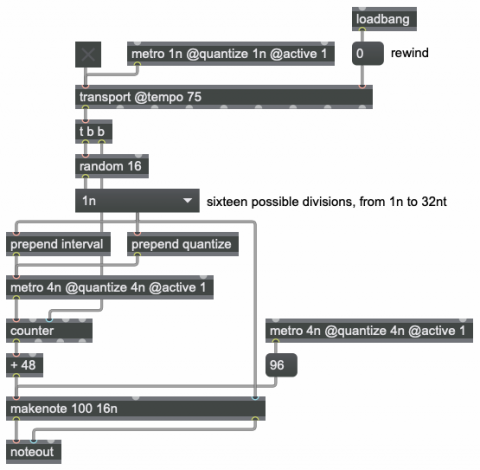Any rhythmic value, with transport

Transport-based tempo-relative timing in Max allows you to specify any rhythmic value. The musical time value syntax allows you to specify duple divisions (1n, 2n, 4n, 8n, 16n, 32n), dotted notes (2nd, 4nd, 8nd, etc.), and triplets (2nt, 4nt, 8nt, etc.). To specify other divisions such as quintuplets, septuplets, and so on, Max doesn't provide note value nomenclature, so you'll need to calculate (or program Max to calculate for you) the correct number of ticks, based on 480 ticks per quarter note (e.g., a quintuplet sixteenth note is 480/5 = 96 ticks). Fortunately, Max understands fractional numbers of ticks, so you can specify septuplet sixteenth notes quite precisely as 480/7 = 68.571429 ticks.
This patch chooses at random from among sixteen possible rhythmic values on the downbeat of every measure, and plays a chromatic scale at the chosen rate. It can divide a measure into 1, 2, 3, 4, 5, 6, 7, 8, 10, 12, 14, 16, 20, 24, 28, 32, or 48 parts. When the transport is turned on, a metro at the top of the patch resets the counter to 0, randomly chooses a rhythmic division from the umenu, and sets another metro to trigger the counter at that rhythmic interval. A third metro plays each beat on high C (MIDI key 96) as a reference point. Note the use of the quantize attribute to ensure that the metronomes' output is perfectly synchronized with the musical timing of the transport.